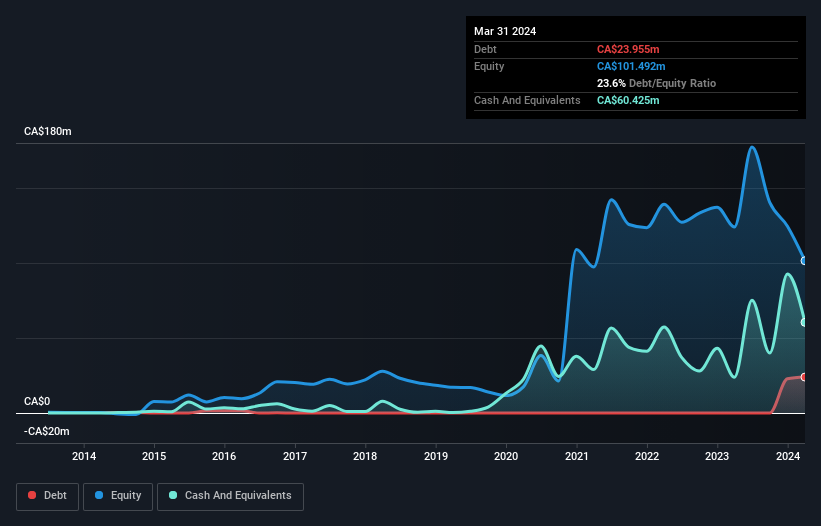Legendary fund manager Li Lu (who Charlie Munger backed) once said, 'The biggest investment risk is not the volatility of prices, but whether you will suffer a permanent loss of capital.' So it seems the smart money knows that debt - which is usually involved in bankruptcies - is a very important factor, when you assess how risky a company is. We can see that Skeena Resources Limited (TSE:SKE) does use debt in its business. But the more important question is: how much risk is that debt creating?
What Risk Does Debt Bring?
Debt assists a business until the business has trouble paying it off, either with new capital or with free cash flow. If things get really bad, the lenders can take control of the business. However, a more usual (but still expensive) situation is where a company must dilute shareholders at a cheap share price simply to get debt under control. Of course, debt can be an important tool in businesses, particularly capital heavy businesses. The first thing to do when considering how much debt a business uses is to look at its cash and debt together.
See our latest analysis for Skeena Resources
How Much Debt Does Skeena Resources Carry?
As you can see below, at the end of March 2024, Skeena Resources had CA$24.0m of debt, up from none a year ago. Click the image for more detail. But it also has CA$60.4m in cash to offset that, meaning it has CA$36.5m net cash.

How Healthy Is Skeena Resources' Balance Sheet?
The latest balance sheet data shows that Skeena Resources had liabilities of CA$20.7m due within a year, and liabilities of CA$45.4m falling due after that. On the other hand, it had cash of CA$60.4m and CA$2.44m worth of receivables due within a year. So its liabilities outweigh the sum of its cash and (near-term) receivables by CA$3.23m.
This state of affairs indicates that Skeena Resources' balance sheet looks quite solid, as its total liabilities are just about equal to its liquid assets. So while it's hard to imagine that the CA$573.0m company is struggling for cash, we still think it's worth monitoring its balance sheet. Despite its noteworthy liabilities, Skeena Resources boasts net cash, so it's fair to say it does not have a heavy debt load! When analysing debt levels, the balance sheet is the obvious place to start. But it is future earnings, more than anything, that will determine Skeena Resources's ability to maintain a healthy balance sheet going forward. So if you're focused on the future you can check out this free report showing analyst profit forecasts.
Since Skeena Resources has no significant operating revenue, shareholders probably hope it will develop a valuable new mine before too long.
So How Risky Is Skeena Resources?
By their very nature companies that are losing money are more risky than those with a long history of profitability. And the fact is that over the last twelve months Skeena Resources lost money at the earnings before interest and tax (EBIT) line. And over the same period it saw negative free cash outflow of CA$121m and booked a CA$120m accounting loss. Given it only has net cash of CA$36.5m, the company may need to raise more capital if it doesn't reach break-even soon. Overall, we'd say the stock is a bit risky, and we're usually very cautious until we see positive free cash flow. There's no doubt that we learn most about debt from the balance sheet. However, not all investment risk resides within the balance sheet - far from it. For example, we've discovered 5 warning signs for Skeena Resources (2 are a bit unpleasant!) that you should be aware of before investing here.
At the end of the day, it's often better to focus on companies that are free from net debt. You can access our special list of such companies (all with a track record of profit growth). It's free.
New: Manage All Your Stock Portfolios in One Place
We've created the ultimate portfolio companion for stock investors, and it's free.
• Connect an unlimited number of Portfolios and see your total in one currency
• Be alerted to new Warning Signs or Risks via email or mobile
• Track the Fair Value of your stocks
Have feedback on this article? Concerned about the content? Get in touch with us directly. Alternatively, email editorial-team (at) simplywallst.com.
This article by Simply Wall St is general in nature. We provide commentary based on historical data and analyst forecasts only using an unbiased methodology and our articles are not intended to be financial advice. It does not constitute a recommendation to buy or sell any stock, and does not take account of your objectives, or your financial situation. We aim to bring you long-term focused analysis driven by fundamental data. Note that our analysis may not factor in the latest price-sensitive company announcements or qualitative material. Simply Wall St has no position in any stocks mentioned.
About TSX:SKE
Skeena Resources
Engages in the exploration and development of mineral properties in Canada.
Excellent balance sheet with reasonable growth potential.
Similar Companies
Market Insights
Community Narratives



